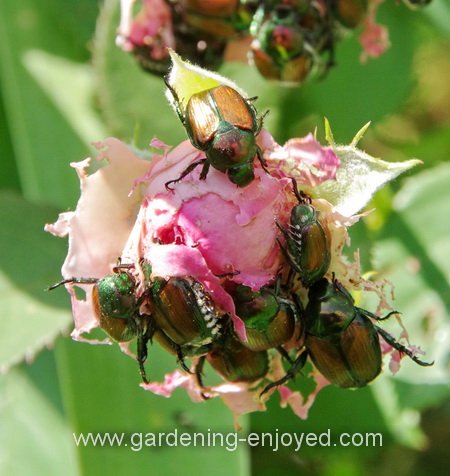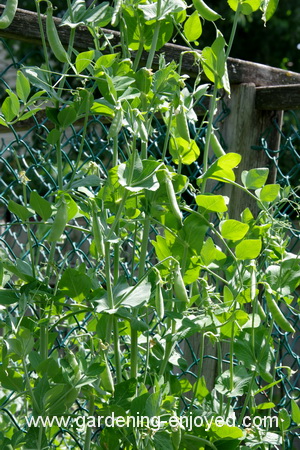
Not a particularly spectacular picture of a Daylily but the first ones just started blooming in the past couple of days. What’s really the point of this picture is all the lovely surrounding fern. That’s the Asparagus. Not only does this garden do double duty as the Asparagus bed and a perennial garden but it keeps all the flower arrangers happy. Any good floral designer would have some greens in their vase before the colourful flowers and here this whole garden has the flowers set off by the Asparagus fern like a giant flower arrangement. I love it when a plan actually works. We have stopped picking Asparagus and are letting it become this lovely lacy fern that looks great while it is regenerating the root for next year’s crop and the Daylilies choose to bloom at the appropriate time.
 This is not nearly as happy a situation. My lovely Witch Hazel has grown quite large and delighted us for years with its early spring blooms and colourful autumn foliage. It appears to be dying. There are two main forks growing from the soil and the biggest has no leaves this year and the bark is all split and falling off. The one in the foreground has rather sparse leaves. If you look at the bottom, the rootstock is producing lots of healthy looking suckers and I think I will leave a few of them grow to see what I get. I suspect it won’t be Diane with her crimson flowers in March. A garden is always changing and sometimes we are not in charge.
This is not nearly as happy a situation. My lovely Witch Hazel has grown quite large and delighted us for years with its early spring blooms and colourful autumn foliage. It appears to be dying. There are two main forks growing from the soil and the biggest has no leaves this year and the bark is all split and falling off. The one in the foreground has rather sparse leaves. If you look at the bottom, the rootstock is producing lots of healthy looking suckers and I think I will leave a few of them grow to see what I get. I suspect it won’t be Diane with her crimson flowers in March. A garden is always changing and sometimes we are not in charge.

The seed catalogue said they were early maturing and how right they were. Fresh green Peppers by the first of July is amazing. This is Accord from Agro Haitai seeds and it is described as a sweet Pepper with possibly a bit of heat and the flavour of a hot Pepper. We haven’t noticed any heat but the flavour is wonderful. We have been picking them rather small just because they are there but as they continue to produce we will let them mature to see if we can get them to the red stage. Lots of small ones and lots of blossoms so they should produce a good sized crop.

Apparently my careful application of beneficial Nematodes to my lawn has not completely stopped the Japanese Beetles from finding the garden. Here they are on their favourite food, a Rose blossom. They seem to quite like Olivia although they are not shy about attacking my hardy Rose tree. I have killed a couple of them on the Asparagus as well. I check the Asparagus for Asparagus beetles every morning and apparently there’s enough for them to share with the Japanese beetles as well. They get the same blast from the spray of insecticidal soap and as they get more numerous I will also carry a bucket of soapy water to catch them when I knock them off the plants. They were on Eggplant and Grapes last year so I will start checking them as well. The regular morning inspection seems to be paying dividends as there is very little damage on the Asparagus
and most of the Squash and Cucumber vines are starting to grow well after their early damage. Now if we can just keep ahead of the Japanese invaders. I tell Mother Nature that I find some of her bugs interesting but I don’t need to have them all visit. She rarely listens to me.
 I hate to say this out loud for fear Mother Nature will hear me and respond but I have not found anything that seems to like these lovely Sugar Snap Peas except for the Assistant Gardener and surely that’s the point of this whole exercise. We have eaten these delicious edible podded Peas a few times already and I cleverly planted another batch a few weeks later and they are just reaching the blossom stage as these first ones are producing. I also have some great Snow Peas and we have developed a pattern of Sugar Snaps one day and Snow Peas the next. Those two day intervals seem to be just right for each type to ripen the next batch. I don’t expect either type to last a long time in this period of excessive heat. Apparently we are going to be over 30 C every day for at least the next week. Early morning gardening is the rule so that we can be out of the sun by mid morning. I have three zones of watering set up on my little watering computer. One is to fill the Earthboxes and the other two are drip irrigation in the planted vegetables and the Asparagus beds. I’m not looking forward to either the water bill or the hydro bill but we are being very well fed with several vegetables at dinner most nights.
I hate to say this out loud for fear Mother Nature will hear me and respond but I have not found anything that seems to like these lovely Sugar Snap Peas except for the Assistant Gardener and surely that’s the point of this whole exercise. We have eaten these delicious edible podded Peas a few times already and I cleverly planted another batch a few weeks later and they are just reaching the blossom stage as these first ones are producing. I also have some great Snow Peas and we have developed a pattern of Sugar Snaps one day and Snow Peas the next. Those two day intervals seem to be just right for each type to ripen the next batch. I don’t expect either type to last a long time in this period of excessive heat. Apparently we are going to be over 30 C every day for at least the next week. Early morning gardening is the rule so that we can be out of the sun by mid morning. I have three zones of watering set up on my little watering computer. One is to fill the Earthboxes and the other two are drip irrigation in the planted vegetables and the Asparagus beds. I’m not looking forward to either the water bill or the hydro bill but we are being very well fed with several vegetables at dinner most nights.
To ask a question just “reply” to this ezine. Don’t forget to check the front page of the Website for frequent short ideas for current gardening activities.
Selma Asks? I enjoy reading your blog. I have a question about building up soil. We have a community garden plot which is not accessible by vehicle. It is a new plot. After we dug out the twitch grass and other weeds, we found very heavy clay soil and no earth worms. We don't have access to leaves or compost. We do have access to wood chips. Will wood chips effectively amend the soil? Problems with wood chips?
Ken Answers!Wood chips may amend the soil but it would take a couple of years before they broke down enough to do any good. Your best option might be to plant it with some annual green crop such as buckwheat or annual rye grass and then work that into the soil later in the summer. That's not going to help you use the plot this year but will help solve the problem eventually.
Barb Asks? Hi Ken I enjoy reading your newsletter . I have a problem with red aphids . They were on a plant of yellow flowers last year I sprayed with soapy water no luck. So I ripped out plant to get rid of them, now they have moved to a plant which I don't know the name of but is very tall with fine yellow flowers on top. Do you know or have any suggestions on how to get rid of them I'm about to rip out this plant too.
Ken Answers! Barb, ripping out the Aphid’s target will only make them find a new target as they are not the least bit fussy about their diet and
you will deprive yourself of that plant’s benefits. The insecticidal soap spray will work but it is a contact spray and has to actually hit the Aphid. The problem is with their ability to reproduce. When you come back to check and they still seem to be there it’s probably the next generation. The answer, do as I do and take a daily walk through the garden looking for problems. If you spray each generation before they have time to reproduce you will eventually come close to eliminating them.

 This is not nearly as happy a situation. My lovely Witch Hazel has grown quite large and delighted us for years with its early spring blooms and colourful autumn foliage. It appears to be dying. There are two main forks growing from the soil and the biggest has no leaves this year and the bark is all split and falling off. The one in the foreground has rather sparse leaves. If you look at the bottom, the rootstock is producing lots of healthy looking suckers and I think I will leave a few of them grow to see what I get. I suspect it won’t be Diane with her crimson flowers in March. A garden is always changing and sometimes we are not in charge.
This is not nearly as happy a situation. My lovely Witch Hazel has grown quite large and delighted us for years with its early spring blooms and colourful autumn foliage. It appears to be dying. There are two main forks growing from the soil and the biggest has no leaves this year and the bark is all split and falling off. The one in the foreground has rather sparse leaves. If you look at the bottom, the rootstock is producing lots of healthy looking suckers and I think I will leave a few of them grow to see what I get. I suspect it won’t be Diane with her crimson flowers in March. A garden is always changing and sometimes we are not in charge. I hate to say this out loud for fear Mother Nature will hear me and respond but I have not found anything that seems to like these lovely Sugar Snap Peas except for the Assistant Gardener and surely that’s the point of this whole exercise. We have eaten these delicious edible podded Peas a few times already and I cleverly planted another batch a few weeks later and they are just reaching the blossom stage as these first ones are producing. I also have some great Snow Peas and we have developed a pattern of Sugar Snaps one day and Snow Peas the next. Those two day intervals seem to be just right for each type to ripen the next batch. I don’t expect either type to last a long time in this period of excessive heat. Apparently we are going to be over 30 C every day for at least the next week. Early morning gardening is the rule so that we can be out of the sun by mid morning. I have three zones of watering set up on my little watering computer. One is to fill the Earthboxes and the other two are drip irrigation in the planted vegetables and the Asparagus beds. I’m not looking forward to either the water bill or the hydro bill but we are being very well fed with several vegetables at dinner most nights.
I hate to say this out loud for fear Mother Nature will hear me and respond but I have not found anything that seems to like these lovely Sugar Snap Peas except for the Assistant Gardener and surely that’s the point of this whole exercise. We have eaten these delicious edible podded Peas a few times already and I cleverly planted another batch a few weeks later and they are just reaching the blossom stage as these first ones are producing. I also have some great Snow Peas and we have developed a pattern of Sugar Snaps one day and Snow Peas the next. Those two day intervals seem to be just right for each type to ripen the next batch. I don’t expect either type to last a long time in this period of excessive heat. Apparently we are going to be over 30 C every day for at least the next week. Early morning gardening is the rule so that we can be out of the sun by mid morning. I have three zones of watering set up on my little watering computer. One is to fill the Earthboxes and the other two are drip irrigation in the planted vegetables and the Asparagus beds. I’m not looking forward to either the water bill or the hydro bill but we are being very well fed with several vegetables at dinner most nights.

